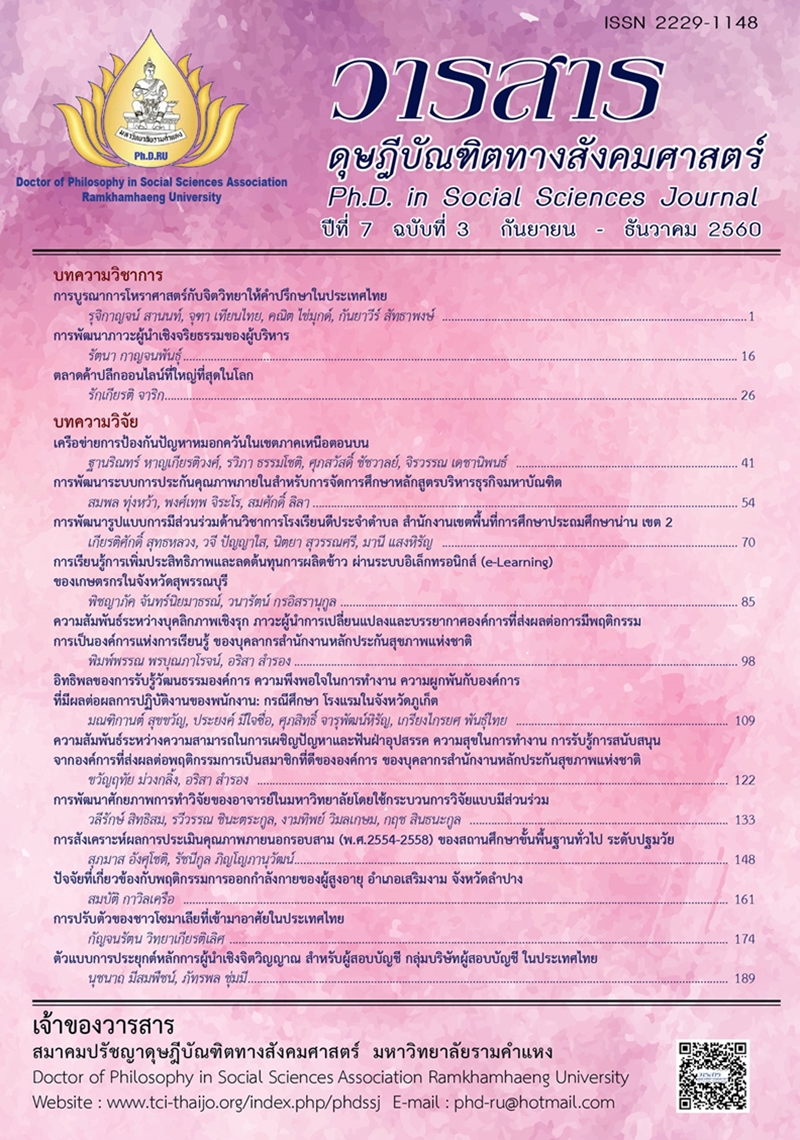การสังเคราะห์ผลการประเมินคุณภาพภายนอกรอบสาม (พ.ศ.2554-2558) ของสถานศึกษาขั้นพื้นฐานทั่วไป ระดับปฐมวัย
Main Article Content
Abstract
การวิจัยนี้ มีวัตถุประสงค์เพื่อ (1) สังเคราะห์ผลการประเมินคุณภาพภายนอกรอบสาม (พ.ศ.2554-2558) และ (2) เปรียบเทียบพัฒนาการผลการประเมินคุณภาพภายนอกรอบสองและรอบสามของสถานศึกษาขั้นพื้นฐานทั่วไปที่เปิดสอนระดับปฐมวัยจำนวนทั้งหมด 28,999 แห่ง และความคิดเห็นของผู้ประเมินภายนอกในเล่มรายงาน จำนวน 290 เล่ม เครื่องมือที่ใช้ในการวิจัย ได้แก่ แบบบันทึกข้อมูลและประเด็นการสนทนากลุ่ม การวิเคราะห์ข้อมูลใช้การแจงนับความถี่ ร้อยละ ค่าเฉลี่ย ส่วนเบี่ยงเบนมาตรฐาน และการวิเคราะห์เนื้อหา
ผลการสังเคราะห์ สรุปได้ดังนี้
1. สถานศึกษาขั้นพื้นฐานทั่วไปที่เปิดสอนระดับปฐมวัยมีจำนวนทั้งสิ้น 28,999 แห่ง ได้รับการรับรองมาตรฐาน 28,057 แห่ง (ร้อยละ 96.75) ส่วนใหญ่มีผลการประเมินระดับดี (ร้อยละ 55.67) รองลงมาคือระดับดีมาก (ร้อยละ 41.08) สถานศึกษาที่ไม่รับรองมาตรฐาน 942 แห่ง (ร้อยละ 3.25) สถานศึกษาสังกัด สกอ. สถานศึกษาขนาดใหญ่ และขนาดใหญ่พิเศษ สถานศึกษาที่ตั้งอยู่ในเมือง และอยู่ในกรุงเทพและปริมณฑลได้รับผลการประเมินสูงกว่าในเกือบทุกด้าน
2. ผลการประเมินตามมาตรฐานที่ 1-4 อยู่ในระดับดี ตัวบ่งชี้ที่มีคะแนนเฉลี่ยตํ่ากว่าตัวบ่งชี้อื่นๆ คือ ตัวบ่งชี้ที่ 3 เด็กมีพัฒนาการด้านสังคมสมวัย ตัวบ่งชี้ที่ 4 เด็กมีพัฒนาการด้านสติปัญญาสมวัย ตัวบ่งชี้ที่ 6 ประสิทธิผลของการจัดประสบการณ์การเรียนรู้ที่เน้นเด็กเป็นสำคัญ และตัวบ่งชี้ที่ 7 ประสิทธิภาพของการบริหารจัดการและการพัฒนาสถานศึกษา
3. สถานศึกษาที่มีพัฒนาการคงที่ทั้งสองรอบแบบ ดี & ดี ร้อยละ 41.62 มีพัฒนาการเพิ่มขึ้น 1 ระดับ แบบ ดี -> ดีมากร้อยละ 27.11 สถานศึกษาสังกัด สกอ. สถานศึกษาขนาดใหญ่ และขนาดใหญ่พิเศษ สถานศึกษาที่ตั้งอยู่ในเมืองมีพัฒนาการแบบ ดีมาก & ดีมาก และดี -> ดีมาก มากกว่าสถานศึกษาอื่นๆ
SYNTHESIS OF RESULTS OF THE THIRD EXTERNAL QUALITY ASSESSMENT (2011-2015) AMONG THE GENERAL BASIC EDUCATION SCHOOLS AT ELEMENTARY LEVEL
The objectives of this research were: (1) to synthesize results of the third external quality assessment (2011-2015); and (2) to compare result development between the second and third external quality assessments. Among 28,999 general basic education schools providing elementary level and receiving certification of assessment results from the Executive Board, Office of Nation Education Standards and Quality Assessment (ONESQA), and 290 opinion reports of the external assessors. Research tools were data recording form and issues on focus group discussion. The data were analyzed as frequency, percentage, mean, SD, and content analysis.
Synthesized results were summarized as follows:
1. A total of 28,057 general basic education schools (96.75 %) were accredited. Most of them had assessment results at the good level (55.67), followed by the very good level (41.08%). The schools under Office of the Higher Education Commission, large and special large school, urban schools, and schools in Bangkok and its vicinity had higher assessment results in almost aspects.
2. The assessment results according to the first to fourth standard were at the good level. The indicators with lower scores than the other indicators were the third indicator on the child with appropriate age-based social development, the fourth indicator on the child with age-based intellectual development, the sixth indicator on effectiveness of child-based learning experience management, and the seventh indicator on efficiency of school administration and development.
3. About 41.62 percentage of the schools had stable development of both assessments at the good and good levels with 1 higher development level at the good to very good level (27.11 %). The schools under Office of the Higher Education Commission, large and special large schools, and urban schools had development at the very good and very good levels, and good to very good more than the other schools.
Article Details
Academic articles, research articles, and book reviews in the Ph.D. in Social Sciences Journal are author’s opinions, and not the publisher’s, and is not the responsibility of the Ph.D. in Social Sciences Journal Philosophy Association, Ramkhamhaeng University. (In the case that research is done on human, the researcher has to be trained in Ethics for Doing Research on Human Training and has to produce the evidence of the training).


